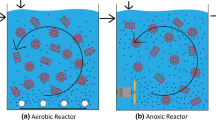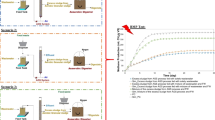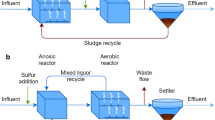Abstract
Sulfamethoxazole (SMX) is one of the antibiotics most frequently detected in effluents from conventional wastewater treatment plants, which increases the concern about the possible impacts on the aquatic biota and public health regarding the emergence of bacteria resistant to this drug. Anaerobic fixed bed reactors are supposed to enhance antibiotic biodegradation due to the biofilm formation in the reactor. In this context, this study evaluated the dynamics of the microbial community in the biofilm of three inoculum sources taken from Upflow Anaerobic Sludge Blanket (UASB) reactors for the biodegradation of SMX in anaerobic structured bed biofilm reactor (ASBBR) with: poultry slaughterhouse sludge (PS), brewery sludge (BS) and domestic sewage sludge (SS). The ASBBR reached high COD (Chemical Oxygen Demand) removal (> 84%) and biomethane yield (> 276 mLCH4 g−1 CODremoved) for all inocula. The bioreactor operation with PS inoculum presented the best SMX removal (90 ± 5%), while the BS and SS inocula resulted in 84 ± 6% and 70 ± 5% removal, respectively. The kinetic profiles of COD and SMX removal indicated the occurrence of cometabolic biodegradation of sulfonamide. The molecular biology analysis showed that the microbial community of the SS inoculum suffered significant changes during the ASBBR operation for the Archaea and Bacteria domains and the biomass of PS presented more similarity to the inoculum, indicating a better SMX adaptation, in agreement with the higher SMX removal. Furthermore, the diversity of the Archaea domain (mainly Methanosaeta and Methanosarcina) increased in the biomass after each reactor operation compared to the raw inocula, indicating that the methanogenic pathway was favored during the anaerobic digestion. The experimental results showed that the inoculum source plays an important role in the SMX biodegradation during the biological wastewater treatment.





Similar content being viewed by others
References
Adorno M, Hirasawa J, Varesche M (2014) Development and validation of two methods to quantify volatile acids. Am J Anal Chem 5(May):406–414. https://doi.org/10.4236/ajac.2014.57049
Alvarino T, Suarez S, Lema JM, Omil F (2014) Understanding the removal mechanisms of PPCPs and the influence of main technological parameters in anaerobic UASB and aerobic CAS reactors. J Hazard Mater 278:506–513. https://doi.org/10.1016/j.jhazmat.2014.06.031
American Public Health Association (APHA) (2005) Standard methods for the examination of water and wastewater. american water works association/American public works association/water environment federation, 21st edn. American Water Works Association/American Public Works Association/Water Environment Federation, Washington, DC, USA. https://doi.org/10.2105/AJPH.51.6.940-a
Briones A, Raskin L (2003) Diversity and dynamics of microbial communities in engineered environments and their implications for process stability. Curr Opin Biotechnol. https://doi.org/10.1016/S0958-1669(03)00065-X
Camargo EFM, Ratusznei SM, Rodrigues JAD, Zaiat M, Borzani W (2002) Treatment of low-strength wastewater using immobilized biomass in a sequencing batch external loop reactor: Influence of the medium superficial velocity on the stability and performance. Braz J Chem Eng 19(3):267–275. https://doi.org/10.1590/S0104-66322002000300001
Carneiro RB, Sabatini CA, Santos-Neto ÁJ, Zaiat M (2019) Feasibility of anaerobic packed and structured-bed reactors for sulfamethoxazole and ciprofloxacin removal from domestic sewage. Sci Total Environ 678:419–429. https://doi.org/10.1016/j.scitotenv.2019.04.437
Carneiro RB, Gonzalez-Gil L, Londoño YA, Zaiat M, Carballa M, Lema JM (2020a) Acidogenesis is a key step in the anaerobic biotransformation of organic micropollutants. J Hazard Mater 389:121888. https://doi.org/10.1016/j.jhazmat.2019.121888
Carneiro RB, Mukaeda CM, Sabatini CA, Santos-Neto ÁJ, Zaiat M (2020b) Influence of organic loading rate on ciprofloxacin and sulfamethoxazole biodegradation in anaerobic fixed bed biofilm reactors. J Environ Manag. https://doi.org/10.1016/j.jenvman.2020.111170
Cerreta G, Roccamante MA, Plaza-Bolaños P, Oller I, Aguera A, Malato S, Rizzo L (2020) Advanced treatment of urban wastewater by UV-C/free chlorine process: micro-pollutants removal and effect of UV-C radiation on trihalomethanes formation. Water Res. https://doi.org/10.1016/j.watres.2019.115220
Cetecioglu Z, Ince B, Orhon D, Ince O (2016) Anaerobic sulfamethoxazole degradation is driven by homoacetogenesis coupled with hydrogenotrophic methanogenesis. Water Res 90:79–89. https://doi.org/10.1016/j.watres.2015.12.013
Chatila S, Amparo MR, Carvalho LS, Penteado ED, Tomita IN, Santos-Neto ÁJ et al (2016) Sulfamethoxazole and ciprofloxacin removal using a horizontal-flow anaerobic immobilized biomass reactor. Environ Technol (united Kingdom) 37(7):847–853. https://doi.org/10.1080/09593330.2015.1088072
Chernicharo CAL, van Lier JB, Noyola A, Bressani Ribeiro T (2015) Anaerobic sewage treatment: state of the art, constraints and challenges. Rev Environ Sci Biotechnol 14(4):649–679. https://doi.org/10.1007/s11157-015-9377-3
Danner M, Robertson A, Behrends V, Reiss J (2019) Antibiotic pollution in surface fresh waters : Occurrence and effects. Sci Total Environ 664:793–804. https://doi.org/10.1016/j.scitotenv.2019.01.406
Delforno TP, Lacerda GV, Noronha MF, Sakamoto IK, Varesche MBA, Oliveira VM (2017) Microbial diversity of a full-scale UASB reactor applied to poultry slaughterhouse wastewater treatment: Integration of 16S rRNA gene amplicon and shotgun metagenomic sequencing. Microbiol Open 6:e443. https://doi.org/10.1002/mbo3.443
Du L, Xu W, Liu Y, Li X, Huang D, Wu S (2020) Removal of sulfamethoxazole in aqueous solutions by iron-based advanced oxidation processes: performances and mechanisms. Water Air Soil Pollut. https://doi.org/10.1007/s11270-020-04534-w
Escudié R, Cresson R, Delgenès JP, Bernet N (2011) Control of start-up and operation of anaerobic biofilm reactors: an overview of 15 years of research. Water Res 45(1):1–10. https://doi.org/10.1016/j.watres.2010.07.081
Fischer K, Majewsky M (2014) Cometabolic degradation of organic wastewater micropollutants by activated sludge and sludge-inherent microorganisms. Appl Microbiol Biotechnol 98(15):6583–6597. https://doi.org/10.1007/s00253-014-5826-0
Fountoulakis M, Drilla P, Stamatelatou K, Lyberatos G (2004) Toxic effect of pharmaceuticals on methanogenesis. Water Sci Technol 50(5):335–340. https://doi.org/10.2166/wst.2004.0346
Gonzalez-Gil L, Carballa M, Lema JM (2017) Cometabolic enzymatic transformation of organic micropollutants under methanogenic conditions. Environ Sci Technol 51(5):2963–2971. https://doi.org/10.1021/acs.est.6b05549
Grenni P, Ancona V, Barra Caracciolo A (2018) Ecological effects of antibiotics on natural ecosystems: a review. Microchem J 136:25–39. https://doi.org/10.1016/j.microc.2017.02.006
Gworek B, Kijeńska M, Wrzosek J, Graniewska M (2021) Pharmaceuticals in the soil and plant environment: a review. Water Air Soil Pollut. https://doi.org/10.1007/s11270-020-04954-8
Hammer Ø, Harper DAT, Ryan PD (2001) PAST: paleontological statistics software package for educatioon and data analysis. https://palaeo-electronica.org/2001_1/past/issue1_01.htm
Kang AJ, Brown AK, Wong CS, Yuan Q (2018) Removal of antibiotic sulfamethoxazole by anoxic/anaerobic/oxic granular and suspended activated sludge processes. Biores Technol. https://doi.org/10.1016/j.biortech.2017.12.021
Kennes-Veiga DM, Gonzalez-Gil L, Carballa M, Lema JM (2021) The organic loading rate affects organic micropollutants’ cometabolic biotransformation kinetics under heterotrophic conditions in activated sludge. Water Res 189:116587. https://doi.org/10.1016/j.watres.2020.116587
Kim S, Rossmassler K, Broeckling CD, Galloway S, Prenni J, De Long SK (2017) Impact of inoculum sources on biotransformation of pharmaceuticals and personal care products. Water Res 125:227–236. https://doi.org/10.1016/j.watres.2017.08.041
Langbehn RK, Michels C, Soares HM (2021) Antibiotics in wastewater: from its occurrence to the biological removal by environmentally conscious technologies. Environ Pollut 275:116603. https://doi.org/10.1016/j.envpol.2021.116603
Li L, Yang X, Li X, Zheng M, Chen J, Zhang Z (2011) The influence of inoculum sources on anaerobic biogasification of NaOH-treated corn stover. Energy Sources Part a: Recovery Util Environ Effects 33(2):138–144. https://doi.org/10.1080/15567030902937192
Li Y, Feng L, Zhang R, He Y, Liu X, Xiao X et al (2013) Influence of inoculum source and pre-incubation on bio-methane potential of chicken manure and corn stover. Appl Biochem Biotechnol 171(1):117–127. https://doi.org/10.1007/s12010-013-0335-7
Lima Gomes PCF, Tomita IN, Santos-Neto ÁJ, Zaiat M (2015) Rapid determination of 12 antibiotics and caffeine in sewage and bioreactor effluent by online column-switching liquid chromatography/tandem mass spectrometry. Anal Bioanal Chem 407(29):8787–8801. https://doi.org/10.1007/s00216-015-9038-y
Liu S, Hassan SU, Ding H, Li S, Jin F, Miao Z et al (2020) Removal of sulfamethoxazole in water by electro-enhanced Co2+/peroxydisulfate system with activated carbon fiber-cathode. Chemosphere 245:125644. https://doi.org/10.1016/j.chemosphere.2019.125644
Monteoliva-García A, Martín-Pascual J, Muñío MM, Poyatos JM (2020) Effects of carrier addition on water quality and pharmaceutical removal capacity of a membrane bioreactor—advanced oxidation process combined treatment. Sci Total Environ. https://doi.org/10.1016/j.scitotenv.2019.135104
Moreno-Andrade I, Buitrón G (2004) Influence of the origin of the inoculum on the anaerobic biodegradability test. Water Sci Technol 49(1):53–59. https://doi.org/10.2166/wst.2004.0017
Muyzer G, de Waal EC, Uitterlinden AG (1993) Profiling of complex microbial populations by denaturing gradient gel electrophoresis analysis of polymerase chain reaction-amplified genes coding for 16S rRNA. Appl Environ Microbiol 59(3):695–700. https://doi.org/10.1128/aem.59.3.695-700.1993
Neves L, Oliveira R, Alves MM (2004) Influence of inoculum activity on the bio-methanization of a kitchen waste under different waste/inoculum ratios. Process Biochem 39(12):2019–2024. https://doi.org/10.1016/j.procbio.2003.10.002
Oliveira GHD, Santos-Neto AJ, Zaiat M (2017) Removal of the veterinary antimicrobial sulfamethazine in a horizontal-flow subjectanaerobic immobilized biomass (HAIB) reactor ed to step changes in the applied organic loading rate. J Environ Manag 204:674–683. https://doi.org/10.1016/j.jenvman.2017.09.048
Park J, Kim C, Hong Y, Lee W, Chung H, Jeong DH, Kim H (2020) Distribution and removal of pharmaceuticals in liquid and solid phases in the unit processes of sewage treatment plants. Int J Environ Res Public Health. https://doi.org/10.3390/ijerph17030687
Priya M, Meenambal T, Balasubramanian N, Perumal B (2015) Comparative study of treatment of sago wastewater using HUASB reactor in the presence and absence of effective microorganisms. Procedia Earth Planet Sci 11:483–490. https://doi.org/10.1016/j.proeps.2015.06.048
Reis AC, Kolvenbach BA, Nunes OC, Corvini PFX (2020) Biodegradation of antibiotics: the new resistance determinants—part I. New Biotechnol 54:34–51. https://doi.org/10.1016/j.nbt.2019.08.002
Ripley LE, Boyle WC, Converse JC (1986) Improved alkalimetricmonitoring for anaerobic digestion of high-Strenght wastes. Water Pollut Control Fed. https://doi.org/10.1109/APMC.2005.1606770
Rodriguez RP, Zaiat M (2011) Influence of carbon source and inoculum type on anaerobic biomass adhesion on polyurethane foam in reactors fed with acid mine drainage. Biores Technol 102(8):5060–5065. https://doi.org/10.1016/j.biortech.2011.01.084
Shahmahdi N, Dehghanzadeh R, Aslani H, Bakht Shokouhi S (2020) Performance evaluation of waste iron shavings (Fe0) for catalytic ozonation in removal of sulfamethoxazole from municipal wastewater treatment plant effluent in a batch mode pilot plant. Chem Eng J 383:123093. https://doi.org/10.1016/j.cej.2019.123093
Singh R, Singh AP, Kumar S, Giri BS, Kim KH (2019) Antibiotic resistance in major rivers in the world: a systematic review on occurrence, emergence, and management strategies. J Clean Prod 234:1484–1505. https://doi.org/10.1016/j.jclepro.2019.06.243
Su D, Ben W, Strobel BW, Qiang Z (2021) Impacts of wastewater treatment plant upgrades on the distribution and risks of pharmaceuticals in receiving rivers. J Hazard Mater. https://doi.org/10.1016/j.jhazmat.2020.124331
Van Boeckel TP, Gandra S, Ashok A, Caudron Q, Grenfell BT, Levin SA, Laxminarayan R (2014) Global antibiotic consumption 2000 to 2010: an analysis of national pharmaceutical sales data. Lancet Infect Dis 14(8):742–750. https://doi.org/10.1016/S1473-3099(14)70780-7
Wang S, Wang J (2018) Degradation of emerging contaminants by acclimated activated sludge. Environ Technol (united Kingdom) 39(15):1985–1993. https://doi.org/10.1080/09593330.2017.1345989
Yun MK, Wu Y, Li Z, Zhao Y, Waddell MB, Ferreira AM et al (2012) Catalysis and sulfa drug resistance in dihydropteroate synthase. Science. https://doi.org/10.7551/mitpress/8876.003.0036
Zaiat M, Cabral AKA, Foresti E (1994) Reator anaeróbio horizontal de leito fixo para tratamento de águas residuárias: concepção e avaliação preliminar de desempenho. Rev Bras Eng Quím 11(2):33–42
Zhao W, Sui Q, Mei X, Cheng X (2018) Efficient elimination of sulfonamides by an anaerobic/anoxic/oxic-membrane bioreactor process: performance and influence of redox condition. Sci Total Environ. https://doi.org/10.1016/j.scitotenv.2018.03.207
Zinatizadeh AA, Mohammadi P, Mirghorayshi M, Ibrahim S, Younesi H, Mohamed AR (2017) An anaerobic hybrid bioreactor of granular and immobilized biomass for anaerobic digestion (AD) and dark fermentation (DF) of palm oil mill effluent: mass transfer evaluation in granular sludge and role of internal packing. Biomass Bioenerg 103:1–10. https://doi.org/10.1016/j.biombioe.2017.05.006
Acknowledgements
This work was supported by the São Paulo Research Foundation (FAPESP—processes nº 2017/18718-6, 2015/06246-7, 2015/04427-4 and 2009/53850-6) and the Coordination for the Improvement of Higher Education Personnel (CAPES—Finance Code 001). The authors would also like to thank Dr. Eloisa Pozzi and Dr. Maria Angela for their technical and scientific support.
Author information
Authors and Affiliations
Corresponding author
Ethics declarations
Conflict of interest
No conflict of interest.
Additional information
Publisher's Note
Springer Nature remains neutral with regard to jurisdictional claims in published maps and institutional affiliations.
Supplementary Information
Below is the link to the electronic supplementary material.
Rights and permissions
About this article
Cite this article
Sella, C.F., Carneiro, R.B., Sabatini, C.A. et al. Can different inoculum sources influence the biodegradation of sulfamethoxazole antibiotic during anaerobic digestion?. Braz. J. Chem. Eng. 39, 35–46 (2022). https://doi.org/10.1007/s43153-021-00178-3
Received:
Revised:
Accepted:
Published:
Issue Date:
DOI: https://doi.org/10.1007/s43153-021-00178-3




